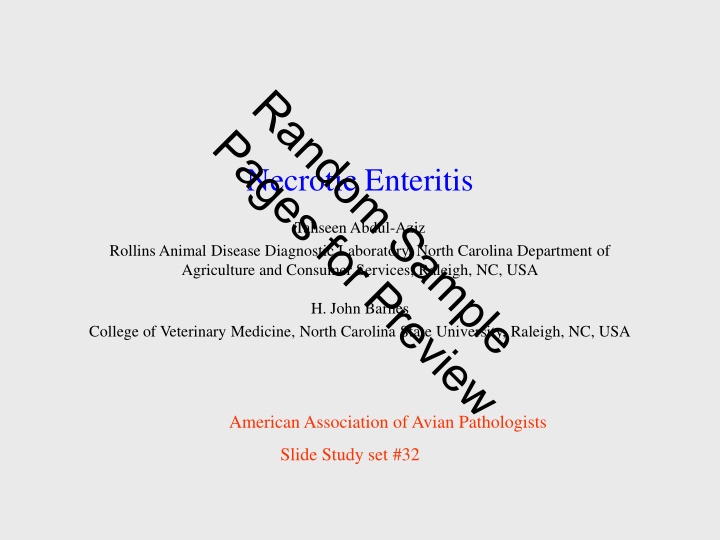



R a P n d a o g Necrotic Enteritis m e s S Tahseen Abdul-Aziz f o a Rollins Animal Disease Diagnostic Laboratory, North Carolina Department of r m Agriculture and Consumer Services, Raleigh, NC, USA P p r H. John Barnes l e e v College of Veterinary Medicine, North Carolina State University, Raleigh, NC, USA i e w American Association of Avian Pathologists Slide Study set #32
R a P n d a o g m e s Slide Study Sets are produced and distributed by the American Association of Avian S Pathologists, Inc. (AAAP). Reproduction is prohibited without permission. Images may be f o used for educational purposes as long as credit is given to AAAP. This Slide Set was a produced and updated through the leadership of the AAAP Education and Electronic r m Information Committees and the generous contributions of the slide study set authors. P p r l e e American Association of Avian Pathologists, Inc. v 12627 San Jose Blvd., Suite 202 i Jacksonville, FL 32223 e w aaap@aaap.info www.aaap.info
Necrotic Enteritis. Slide Study Set T. Abdul-Aziz American Association of Avian Pathologists H. John Barnes R a Necrotic enteritis (NE) is an enteric bacterial disease of chickens, turkeys, and a few other avian P n species caused by Clostridium perfringens . The disease is characterized by damage to the intestinal d a mucosa by toxins produced by the causative bacteria. It occurs worldwide and causes considerable o g financial losses to broiler producers due to mortality, treatment cost, and, in its milder subclinical m e form, poor growth and feed utilization. The disease was first reported in chickens in 1961. s S f o a r m P p r l e e v i e w 1
Necrotic Enteritis. Slide Study Set T. Abdul-Aziz American Association of Avian Pathologists H. John Barnes R Etiology a P n Clostridium perfringens d a Gram-positive, obligatory anaerobe, nonmotile, rod-shaped, spore-forming bacterium. o g Grows at a temperature between 15 o C and 50 o C, with an optimum growth at 45 o C for most m e s strains. S Generation time for most strains is less than 20 minutes at 33 o C to 49 o C; a generation time of 8 f o a minutes has been reported. r m Spores can withstand 100 o C for two hours. P p r On blood agar, colonies usually show double-zone hemolysis with a clear inner theta-toxin zone l e e and a hazy outer zone caused by alpha-toxin. v i e w 2
Necrotic Enteritis. Slide Study Set T. Abdul-Aziz American Association of Avian Pathologists H. John Barnes R a P n d a o g m e s S f o a r m P p r l e e v i e w Broiler chicken, 31 days, jejunum/ileum, necrotic enteritis. Jejunum and ileum are dilated and thin-walled. Only birds that have been euthanized or died recently can be evaluated, as the changes seen here can result from postmortem decomposition because of gas that 22 increases in the gut after the bird dies.
Necrotic Enteritis. Slide Study Set T. Abdul-Aziz American Association of Avian Pathologists H. John Barnes R a P n d a o g m e s S f o a r m P p r l e e v i e w Broiler chicken, 35 days, jejunum/ileum, necrotic enteritis. Jejunum and ileum are dilated, have firm walls, and are distended with fluid contents. 23
Necrotic Enteritis. Slide Study Set T. Abdul-Aziz American Association of Avian Pathologists H. John Barnes R a P n d a o g m e s S f o a r m P p r l e e v i e w Broiler chicken, 15 days, jejunum/ileum, necrotic enteritis. Jejunum and ileum are dilated and markedly reddened. Such an appearance for the intestine is unusual in birds with necrotic enteritis. The bird was negative for coccidiosis. 24
Necrotic Enteritis. Slide Study Set T. Abdul-Aziz American Association of Avian Pathologists H. John Barnes R a P n d a o g m e s S f o a r m P p r l e e v i e w Broiler chicken, 38 days, jejunum/ileum, necrotic enteritis and coccidiosis ( Eimeria maxima ). Jejunum and ileum are dilated, markedly hemorrhagic, and filled with bloody contents. 25
Recommend
More recommend